 For current events in your class, use the Earth Observatory website for NASA satellite images showing the path of exposed ground left in the wake of recent tornadoes. You will find images taken by the Moderate Resolution Imaging Spectroradiometer, or MODIS, aboard NASA’s Aqua satellite on April 28, 2011.
For current events in your class, use the Earth Observatory website for NASA satellite images showing the path of exposed ground left in the wake of recent tornadoes. You will find images taken by the Moderate Resolution Imaging Spectroradiometer, or MODIS, aboard NASA’s Aqua satellite on April 28, 2011.To find more information about tornado images on the Earth Observatory website, refer to the Earth Observatory article in NEON.
Link to the NES Virtual Campus home page.

 The Moderate Resolution Imaging Spectroradiometer, or MODIS, on NASA’s Aqua satellite and the MODIS sensor on NASA’s Terra satellite took photos of Japan’s earthquake and tsunami. Images were made with infrared and visible light to highlight the presence of water and other features on the ground.
The Moderate Resolution Imaging Spectroradiometer, or MODIS, on NASA’s Aqua satellite and the MODIS sensor on NASA’s Terra satellite took photos of Japan’s earthquake and tsunami. Images were made with infrared and visible light to highlight the presence of water and other features on the ground.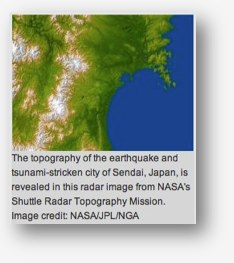 The March 11, magnitude 9.0 earthquake in Japan may have shortened the length of each Earth day and shifted its axis. But don’t worry—you won’t notice the difference.
The March 11, magnitude 9.0 earthquake in Japan may have shortened the length of each Earth day and shifted its axis. But don’t worry—you won’t notice the difference.
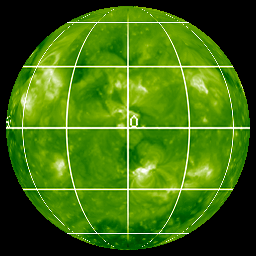 This movie shows a spherical map of the Sun, formed from a combination of STEREO Ahead and Behind beacon images, along with an SDO/AIA image in between. The movie starts with the view of the Sun as seen from Earth, with the 0 degree meridian line in the middle. The map then rotates through 360 degrees to show the part of the Sun not visible from Earth. The black wedge shows the part of the Sun not yet visible to the STEREO spacecraft.
This movie shows a spherical map of the Sun, formed from a combination of STEREO Ahead and Behind beacon images, along with an SDO/AIA image in between. The movie starts with the view of the Sun as seen from Earth, with the 0 degree meridian line in the middle. The map then rotates through 360 degrees to show the part of the Sun not visible from Earth. The black wedge shows the part of the Sun not yet visible to the STEREO spacecraft.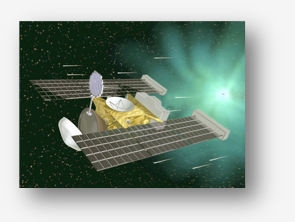 On Feb. 14, 2011, NASA’s Stardust-NExT (New Exploration of Tempel 1) mission will encounter Comet Tempel 1, providing a unique opportunity to measure the dust properties of two separate comets (Wild 2 and Tempel 1) with the same instrument for accurate data comparison. The encounter also will provide a comparison between two observations of a single comet, Tempel 1, taken before and after a single orbital pass around the sun.
On Feb. 14, 2011, NASA’s Stardust-NExT (New Exploration of Tempel 1) mission will encounter Comet Tempel 1, providing a unique opportunity to measure the dust properties of two separate comets (Wild 2 and Tempel 1) with the same instrument for accurate data comparison. The encounter also will provide a comparison between two observations of a single comet, Tempel 1, taken before and after a single orbital pass around the sun.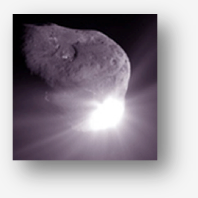 NASA’s Deep Impact mission observed Comet Tempel 1 in the summer of 2005, as the comet was inbound toward the sun on its approximately 5.5-year orbit between Mars and Jupiter. Deep Impact’s primary mission was to deliver a special impactor spacecraft into the path of Comet Tempel 1. The spacecraft — and many ground-based observers — observed the impact and the ejected material. Scientists were surprised the cloud was composed of a fine, powdery material, not the expected water, ice and dirt. The spacecraft did find the first evidence of surface ice on a comet instead of just inside a comet.
NASA’s Deep Impact mission observed Comet Tempel 1 in the summer of 2005, as the comet was inbound toward the sun on its approximately 5.5-year orbit between Mars and Jupiter. Deep Impact’s primary mission was to deliver a special impactor spacecraft into the path of Comet Tempel 1. The spacecraft — and many ground-based observers — observed the impact and the ejected material. Scientists were surprised the cloud was composed of a fine, powdery material, not the expected water, ice and dirt. The spacecraft did find the first evidence of surface ice on a comet instead of just inside a comet. A new generation of small, smart, versatile robotic landers will aid in the exploration of airless bodies such as the moon and asteroids. The design is based on cutting-edge technology, which allows precision landing in high-risk but high-priority areas. This technology enables NASA to achieve scientific and exploration goals in previously unexplored locations.
A new generation of small, smart, versatile robotic landers will aid in the exploration of airless bodies such as the moon and asteroids. The design is based on cutting-edge technology, which allows precision landing in high-risk but high-priority areas. This technology enables NASA to achieve scientific and exploration goals in previously unexplored locations.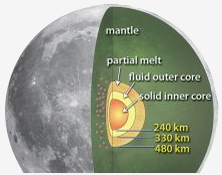 Are you looking for an extension for the Lunar Surface Instrumentation Content Module on the NASA Explorer Schools Virtual Campus? Bring current NASA discoveries into your classroom with this article!
Are you looking for an extension for the Lunar Surface Instrumentation Content Module on the NASA Explorer Schools Virtual Campus? Bring current NASA discoveries into your classroom with this article! On Jan. 21st, NanoSail-D unfurled a 10 m
On Jan. 21st, NanoSail-D unfurled a 10 m